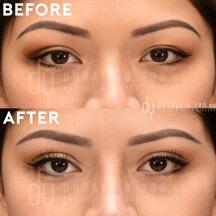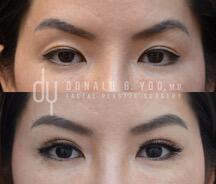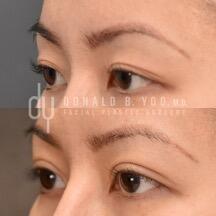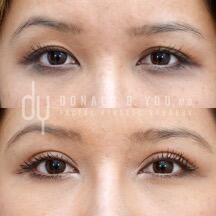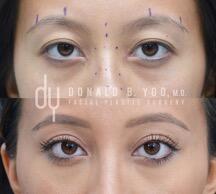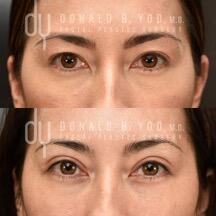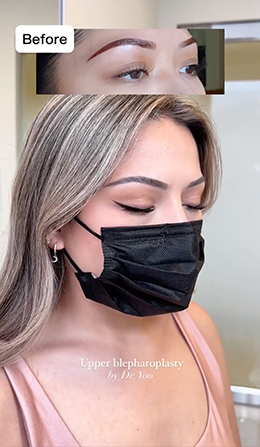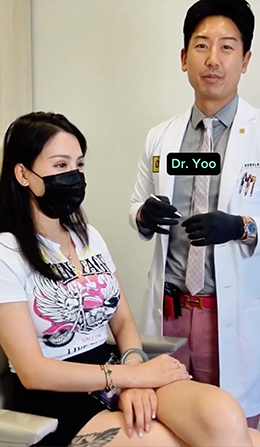SERVICES
Asian Blepharoplasty
What is Asian Blepharoplasty?
Asian Blepharoplasty also known as “double eyelid surgery” or Asian eyelid surgery, refers to a surgical procedure used to improve the appearance of the upper eyelid in Asian patients. One common goal during Asian blepharoplasty is to create or enhance the shape of the upper eyelid crease (supratarsal crease) by surgically creating a stronger connection between the eyelid skin and the underlying muscle and tarsal plate to alter the height, shape, and depth of the upper eyelid crease. Asian blepharoplasty can permanently construct an upper eyelid fold (supratarsal crease), enhance symmetry, and bring about a brighter and more open appearance to the eyes.
Patients can often be confused as to the differences between more traditional upper blepharoplasty (upper eyelid surgery) and Asian blepharoplasty. Traditional upper blepharoplasty may address excess skin and excess fat in the upper eyelid, but it will not establish or modify the shape of an upper eyelid crease given the anatomical differences in the upper eyelid of Asian patients compared to patients of other ethnicities. Mastery of the surgical techniques specific to Asian blepharoplasty, along with a keen appreciation for Asian beauty, are paramount of success in Asian eyelid surgery.
Asian Blepharoplasty
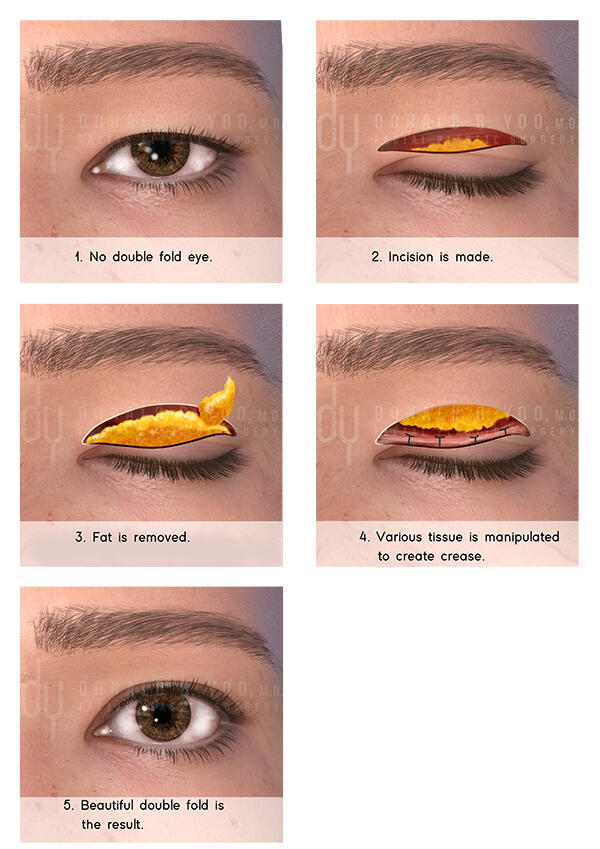
Traditional Upper Blepharoplasty
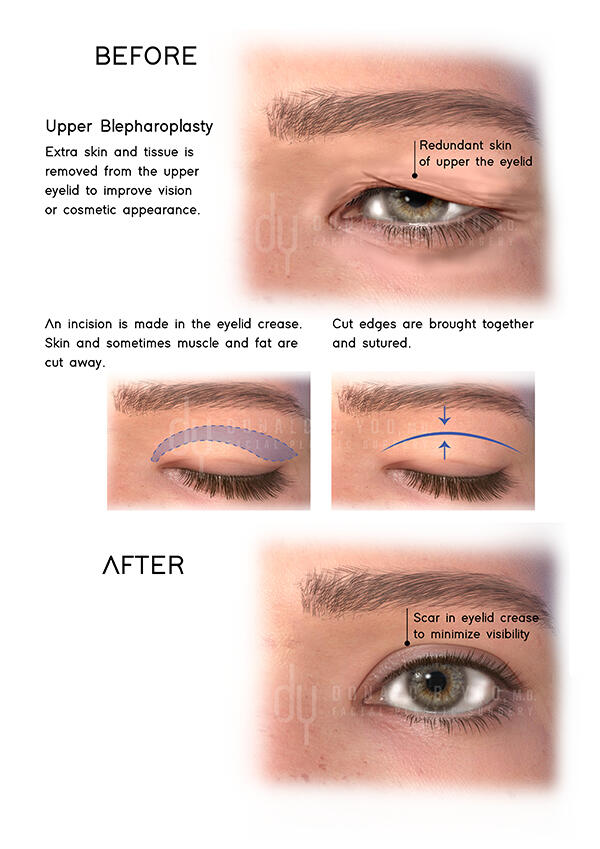
History
Asian blepharoplasty was first described in the medical literature by a Japanese surgeon by the name of Dr. Kotaro Mikamo in 1896. Dr. Mikamo observed the presence of an upper eyelid crease, or “double eyelid”, in the majority of the Japanese population and sought to be able to recreate this for the minority in the population who did not have this. Thus, out of a desire to enhance the natural aesthetics of Asian eyelids he sought to describe a surgical technique by which he could emulate what he saw in the innately beautiful Japanese population. Unlike some misguided surgeons who attempt to “Westernize” the Asian eyelid, Dr. Mikamo sought to accentuate a feature already prevalent and appreciated in Japanese society. In the centuries since, plastic surgeons have continued to refine surgical techniques to optimize Asian blepharoplasty results while minimizing downtime while maximizing a naturally beautiful aesthetic.
Benefits
Asian eyelid surgery encompass a variety of surgical techniques, that when performed by an Asian blepharoplasty specialist like Dr. Donald B. Yoo, will address a number of cosmetic and functional concerns.
Dr. Donald B. Yoo has a practice catering to patients here in Beverly Hills and Los Angeles, as well as from across the country and around the world.
This cosmetic procedure is ideal for patients who do not have visible eyelid creases (sometimes referred to as monolids), in patients who desire a higher or more distinct crease, and in those patients wishing to achieve greater symmetry to their eyelid creases.
Common Concerns
Common concerns patients express while seeking out Asian blepharoplasty include:
- a sagging or drooping appearance to the upper eyelids and eyes
- excess skin and puffiness in the upper eyelid
- lack of a well-formed upper eyelid crease
- a crease that is too low
- or asymmetry between the upper eyelids
During Asian eyelid surgery an incision is designed along the new upper eyelid fold, where it will be completely invisible with the eyes open, and nearly imperceptible with the eyes closed after a few months of healing. Through this incision precise measurements are used to determine the exact amount of skin that can safely be excised while preserving normal eye closure, and any supraorbital fat causing puffiness in the upper eyelid can be repositioned or removed to create a smoother contour.
Many patients seeking Asian blepharoplasty also wish to eliminate excessively wrinkly skin in the upper eyelids, or to create a single discrete crease instead of multiple, variable creases. Some patients notice that depending on their sleep and rest levels the appearance of their upper eyelid crease may change, and sometimes may even lose the presence of their supratarsal crease. The pre-tarsal skin (skin between the eyelashes and upper eyelid crease) can be tightened during Asian eyelid surgery, and any extraneous eyelid creases removed in favor of a single, crisp and well-defined crease.
Some nuances to consider during Asian eyelid surgery include the shape, height and size of the upper eyelid or supratarsal crease, the height of the upper eyelid margin, and the appearance of the medial canthus and lateral canthus.
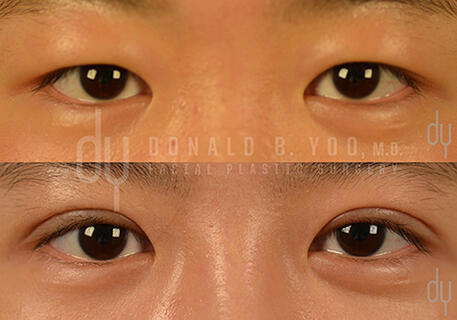
The upper eyelid crease (supratarsal crease) gently tapers and meets the inner corner of the eye

The upper eyelid crease (supratarsal crease) retains space along the upper eyelid platform between the inner corner of the eye and the eyelid margin.
Dr. Yoo looks forward to helping achieve a more beautiful you.
Call now for your consultation: 310-772-0766
Types of Folds
Asian blepharoplasty can permanently construct an upper eyelid fold to create more natural appearing double eyelids, as well as bring a brighter and more open appearance to the upper eyelids. Depending on the patient’s natural eye shape, there are different crease options which are thoroughly discussed during the initial consultation. These different crease options include:
Infold/Tapered crease
A well-defined upper eyelid that runs along the entire length of the eye and merges at medial corners. This tends to create a more subtle appearance to the upper eyelid crease.
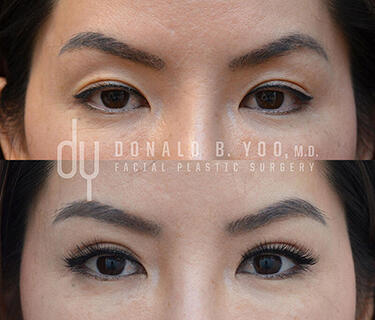
Outfold/Parallel crease
A well-defined upper eyelid crease that runs above the lash line and does not merge with the medial corners of the eyes, but rather runs above and parallel to it. A small outfold can create a larger appearance to the eyes, while preserving a very natural aesthetic, while a large outfold will create the highest, most dramatic upper eyelid crease.
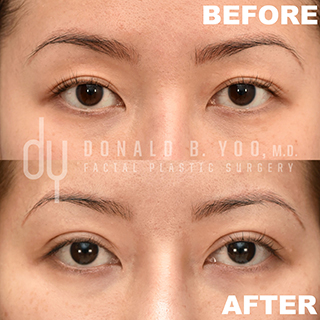
Medial Epicanthoplasty for Epicanthal folds
The appearance of the corners of the eyes, referred to as the medial canthus and lateral canthus, play a significant role in the horizontal size of the eyes. Modification of the inner corner of the eye through medial epicanthoplasty, or the outer corner of the eye through lateral epicanthoplasty, can enlarge and enhance the shape of the eyes in the appropriate patients.
Medial epicanthoplasty addresses the inner corner of the eyes, and more specifically the bridge of skin (epicanthal fold) and soft tissue that covers the inner eye present in some Asian patients. For patients with a prominent epicanthal fold, this can create a larger, more open and symmetric appearance to the eyes. Candidates for this technique will have an epicanthal fold obscuring the lacrimal lake and caruncle (the pink part along the inner corner of the eye).
Another important consideration is the distance between the eyes, or the intercanthal distance. Generally the intercanthal distance should approximate the horizontal width of an eye, and when the distance between the eyes is less than this then medial epicanthoplasty may be considered to improve this relationship and balance.

Lateral Epicanthoplasty (Outer Corner Eye Surgery)
Where the canthal tendons meet along the outer corner of the eyes is referred to as the lateral canthus. The lateral canthal tendons contact the globe, and proper alignment of the tendons maintains normal function of the tear film. Lateral epicanthoplasty addresses the outer corner of the eyes to adjust the shape or width of the eyes to create a larger and brighter appearance.
Consultation with an eyelid surgery specialist will allow for the best way to determine the appropriate eyelid surgery techniques for your eyes.

Ptosis Repair / Droopy Eyelid
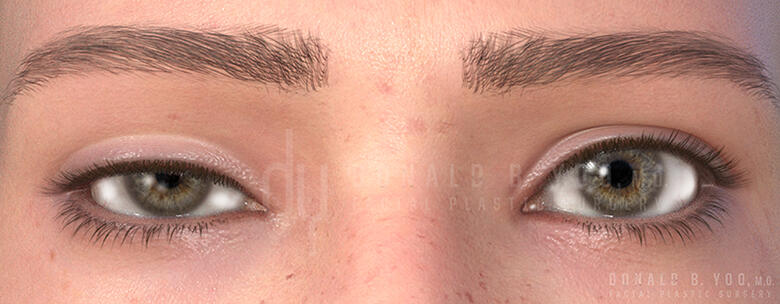
In addition to creating a natural eyelid crease, blepharoplasty can also treat patients who have excess upper eyelid skin with multiple eyelid creases or a droopy eyelid known as “ptosis.” The goal of Asian blepharoplasty is to accentuate the upper eyelid creases to make the eyes appear more alert and bright. Both men and women in good health can be ideal candidates for blepharoplasty.
Ptosis refers to a condition where the upper eyelid margin (edge of the eyelid where the eyelashes emerge) crosses the iris (colored part of the eye) and covers part of the eye, creating a droopy appearance to the eyelid. Patients with ptosis may appear sleepy or tired even when fully rested, and may feel the eye appears smaller on the ptotic side.
Droopiness or ptosis of the upper eyelid can be addressed independently, or at the same time as Asian blepharoplasty with a ptosis repair surgery. During ptosis repair a muscle in the back of the eyelid is tightened, allowing the eyelid margin to lift and create a more open and brighter appearance to the eyes.
Procedure
Asian blepharoplasty is performed under general anesthesia and lasts approximately 2 hours. The procedure begins by carefully measuring and marking the upper eye creases. A skin incision is created along each planned crease of the eyelid. Excess skin, muscle, and sometimes fat is carefully removed and contoured to improve the shape of the upper eylelid. To create a well-defined double eyelid crease, dissolvable sutures are placed to secure the orbicularis muscle to the tarsal plate and levator aponeurosis, known as supratarsal fixation. The skin edges are then carefully closed with sutures and removed after 1 week. Patients may expect moderate swelling and bruising immediately after surgery, and a sensation of restricted upward gaze during the initial week after surgery. Due to the swelling, the eyelids may appear much higher than the final results, though after 2 weeks the eyelids are typically very presentable with makeup. Most patients will feel comfortable returning to work after 2 weeks. The majority of the swelling will resolve over 3-6 months, during which time the upper eyelid crease will settle down to its final position.
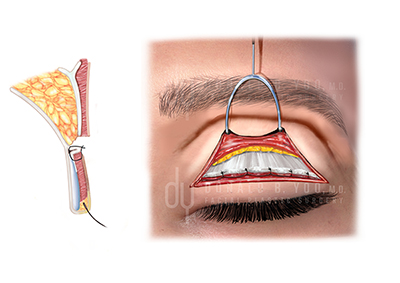
Frequently Asked Questions
What is double eyelid surgery?
Double eyelid surgery, or Asian eyelid surgery, refers to a surgical procedure to reshape the eyelids to create a more aesthetically pleasing upper eyelid crease, with greater definition and symmetry. About half the Asian population has a well-defined supratarsal crease naturally, while half do not have a well-defined upper eyelid crease or have multiple creases.
What are some reasons people decide to get Asian eyelid surgery?
People may choose to undergo Asian blepharoplasty for functional reasons, aesthetic reasons, or a combination of both. In some patients, excess skin and fat in the upper eyelid results in a reduction in the visual fields, while in others the appearance of the eyelids can impart a tired or sleepy look. During Asian eyelid surgery the visual fields can be improved while also enhancing the appearance of the eyes to create a more open and brighter look.
What surgical techniques are used in double eyelid surgery?
The surgical techniques in Asian eyelid surgery rely on creating a strong connection between the skin of the upper eyelids with the underlying muscle to create a crisp upper eyelid crease. Broadly, Asian blepharoplasty can be divided into an incisional technique and a suture technique. In the incisional technique, an incision is made through the skin along the desired crease line, and excess skin, muscle and fat removed or reshaped, and anchoring sutures placed along between the skin and muscle to establish a crisp upper eyelid crease. In the suture technique, three smaller incisions are used along the desired crease line, and permanent sutures buried under the skin to establish the eyelid crease.
What are the advantages/disadvantages of DST (double-suture with twist) blepharoplasty compared to incisional Asian blepharoplasty (eyelid surgery)?
Suture technique double eyelid surgery, like the DST technique, allow for creation of a very natural looking crease in appropriately selected patients with minimal swelling, bruising, and subsequently short downtimes. Suture technique double eyelid surgery is not truly non-incisional, as some mistakenly refer to it, as it does involve three small incisions along the crease line. Patients eligible for suture technique Asian eyelid surgery must have thin skin without excess skin, excellent symmetry between the eyelids, and excellent function and symmetry of the levator muscle (eyelid elevating muscle).
Incisional Asian eyelid surgery allows for the most crisp crease formation, with the ability to address and optimize symmetries of eyelid skin, upper eyelid crease shape, and eyelid margin. Incisional double eyelid surgery does cause more swelling and a longer recovery than suture techniques, but with a much higher rate of permanence. With suture techniques the crease failure rate, or the rate at which the upper eyelid crease unfolds, reaches 10% or more at 10 years, and increases every year thereafter. With incisional double eyelid surgery, the crease failure rate is less that 5%, and is generally permanent.
Double eyelid surgery benefits?
Asian eyelid surgery can create a more defined and crisp upper eyelid crease, with a resultant more youthful and attractive appearance. It can improve visual field deficits caused by excess skin and fat, that may obstruct vision and cause a tired and droopy appearance. Double eyelid surgery can also improve the overall symmetry of the eyes.
Asian eyelid surgery considerations?
- Asian eyelid surgery is a highly individualized procedure, and the specific technique used will depend on the patient's unique anatomy and desired results.
- The procedure can be performed under local or general anesthesia and takes around 1.5 to 2 hours.
- Sutures remain in place for 1 week, and most patients feel comfortable returning to work or school by 2 weeks. The majority of the swelling will subside in the first 2-3 months. Asian eyelid surgery does create quite a bit more swelling than traditional eyelid surgery due to the additional dissection necessary to establish a defined eyelid crease, and it is expected for swelling after Asian eyelid surgery to resolve more slowly than traditional blepharoplasty.
Potential complications include infection, scarring, and incomplete or asymmetrical upper eyelid crease formation. With proper surgical technique and proper incision care, infection is rare. With meticulous surgical technique and proper post-operative care the incisions typically heal as thin lines which fade with time to become almost invisible.
Double eyelid surgery cost?
The cost of Asian eyelid surgery can vary depending on the experience and proficiency of the surgeon, the technique used, geographic location and the complexity of the procedure.
Asian blepharoplasty recovery?
Sutures will remain in the upper eyelid crease for one week, but they do not affect vision and typically cause only mild discomfort due to swelling and tightness. Patients should avoid strenuous activity such as exercise, but are encouraged to ambulate and do light activities of daily living. Most patients feel comfortable returning to the public eye and going back to work or school at 2 weeks after surgery. Healing continues for the next 3-6 months, as swelling resolves and the incisions continue to fade.
How to find a qualified Asian eyelid surgeon?
It’s important to choose a board-certified facial plastic surgeon, oculoplastic surgeon or plastic surgeon with experience in double eyelid surgery.
Is it best to have Asian eyelid surgery in Korea, Japan or California?
Asian eyelid surgery can be a safe and effective way to achieve a desired aesthetic outcome. However, it's important to carefully consider the procedure, its potential risks and benefits, and find a qualified surgeon who can provide personalized care and shares the same aesthetic vision you have for yourself, whether that surgeon is in Korea, Japan or Los Angeles.
What is epichanthoplasty in Asian eyelid surgery?
Epicanthoplasty is a cosmetic surgical procedure that removes or reduces the epicanthal fold, a vertical fold of skin that covers the inner corner of the eye.
What is ptosis repair during Asian eyelid surgery?
Ptosis, also known as a droopy eyelid, is a condition where the upper eyelid sags, obscuring vision. Ptosis correction aims to restore normal eyelid function and improve vision.
Ptosis correction may be combined with other eyelid procedures, such as blepharoplasty (removal of excess eyelid skin).
What techniques of ptosis repair are available during Asian eyelid surgery?
Ptosis, or droopy eyelid, can be repaired through a posterior approach with an incision hidden behind the eyelid, or through an anterior approach through the same incision used for double eyelid surgery.
Dr. Yoo looks forward to helping achieve a more beautiful you.
Call now for your consultation: 310-772-0766
Asian Blepharoplasy Before & After Gallery
Asian Blepharoplasty Videos
Patient Testimonials
I had upper & lower blepharoplasty from Dr Yoo on May 27/2019. It's been 7 months now and I have receive a lot of compliments on how natural and beautiful my eye look even my friends who don't like plastic surgery. Many of my friends, when they see me said "Wow! he is very talented, if I didn't know you before, I wouldn't have known that you had your eyelid surgery. I feel extremely happy to look in the mirror and see a face that look fresh, young, and beautiful. Thank you Dr Yoo for making me look prettier!
Dr. Yoo is an amazing surgeon! Excellent bedside manners, very professional, and compassionate towards his patients. Staff members are friendly, helpful, and accommodating too.
The reason why I chose him was because of his training and impressive portfolio. He pays close attention to detail and is very patient so I knew I could trust him with my face.
I had two procedures done: an upper blepharoplasty and a rhinoplasty. Before, my eyes were asymmetrical and my nose was flat and wide, which had always bothered me. I hated taking pictures.
It’s been a little over a year now and I'm extremely happy with my results!! I look more refined and refreshed. My eyes don't look as tired. Overall, my facial appearance is more aesthetically pleasing. I love how I look from all angles now.
The most important thing for me was that there was a great improvement in how I looked while still looking natural--not too overdone. I think that he found a perfect balance between science and art to achieve just that.

I got an asian rhinoplasty and upper bleph by Dr. Donald Yoo on June 30th, 2020! Even though it has only been around 3 months and I have not seen the final results, I am very happy with it so far. I honestly had such an amazing experience and am so fortunate to have had to opportunity to get work done by Dr. Yoo.
I went to my pre-op with my mom the day before surgery to talk about realistic goals and what we wanted to achieve. For upper bleph, we decided on a natural parallel crease and for my nose, I needed a slimmer, taller bridge as well as a lifted tip. We talked about the procedure and how he would take cartilage from my rib and fascia from my head. The next day, it was time for surgery.
I was extremely nervous once I got to the surgery center but my anesthesiologist made me feel extremely comfortable when he came in the put my IV on. Dr. Yoo came in briefly to make me feel at ease and mark where he would remove my rib. Once I got into the operating room, I pretty much knocked out and when I woke up it was done! I was nervous to be under surgery for so long since I was doing two procedures but it was nothing to be afraid of.
As for the end result, I have not seen it yet since I am still in the healing process but I have attached some pictures. My tip is still the most swollen since I have thick skin but I would say my results look very natural, as if I was born with this nose. All of my follow-up appointments have gone well and the healing process was nothing too crazy. It was much less painful than I expected, overall. Additionally, Dr. Yoo is a fantastic doctor who has amazing bedside manner and really knows what he is doing. There is nobody else I would have gone to. Although pricey, he is worth it.
I am extremely excited for my final results in a year!
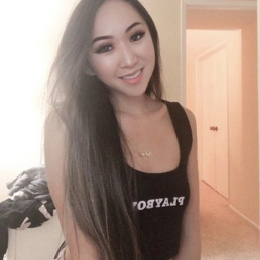
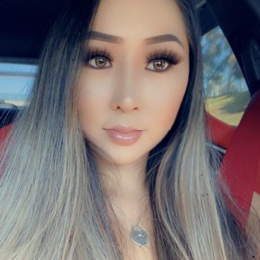
Dr. Don Yoo is truly a caring and compassionate doctor. He has a great artistic eye. I went in for a blepharosphapy, basically Asian double eyelid surgery, and the results are spectacular.
All of the follow-up appointments are there to make sure everything is healing properly and you can tell he wants the best outcome for me.
Also the rest of the team is friendly - thank you!
Got my Asian double eyelid and nose done by Dr. Donald Yoo in Beverly Hills and this review is for the double eyelid surgery.
The surgery has addressed all of my concerns (mostly aesthetic). I got my double eyelid and nose on a same day. I had very thin double eyelids (almost non-existent) and no one knew I had double eyelids. My goal was to increase the height of the crease by 4-5 mm. Dr said this was possible. He was seriously SO helpful and knowledgeable.
Surgery took about 6 hours(double eyelid+rhinoplasty). My eyes looked super swollen right after the surgery because the incisions were freshly sewn back together. It was painful but not too painful. Ever since the stitches were taken out, swelling has been going down rapidly. Dr. Yoo has done such an amazing job. I love how my eyes look even with the swelling. It's at about 5-6mm right now but Dr said it will eventually go down to 3-4mm. Can't wait. I'm really happy with my nose too. I'm also on a low sodium diet for faster recovery and it seems to help.
Having natural yet asymmetrical eyelid creases never bothered me until last year when I started to notice in pictures that my eyes were getting smaller. My girlfriends stared asking me why I was squinting when I wasn’t! Sadly, gravity and age were starting to kick in and I came to the conclusion that it was time to get surgery to freshen up my look and finally even out my asymmetrical eyelids.
I previously consulted with two other doctors, one of which I found extremely unprofessional and the other did not have a impressive portfolio. I decided on Dr. Yoo because I always felt very comfortable and trusted him with all my other nonsurgical procedures (botox/fillers.)
My top two concerns were to 1) cut and remove the excess skin that made my eyelids droopy and 2) make the inner incision of the crease look parallel and NOT tapered. I was very very specific about this as I preferred my left eye parallel crease better. I’m typically not a good healer and so initially I looked like quasimodo post-surgery. As I panicked the first 2 months, Dr. Yoo was always available and attentive to patiently answer all my questions no matter how redundant. The procedure itself was surprisingly pleasant and the staff and nurses went the extra mile to make me feel as comfortable as possible.
It’s been 5 months (surgery in Nov) and I am extremely pleased with the results and so glad I went to Dr. Yoo. He truly delivered everything he promised. Although he told me that it would take a full 6 months to a year for the lids to settle in more naturally, I really think my eyes look amazing right now. I couldn’t be any happier with these results.
Despite being a relative newcomer to the Beverly Hills plastic surgery arena, I consider Dr.Yoo to be one of the best. I highly recommend him because he does a great job understanding what his patient's needs and wants are, then he communicates effectively as to what can and cannot be realistically achieved so that patients know what to expect and finally his execution during surgery and follow-up post-surgery are top notch. He really cares about his patients and is truly passionate about his work.
Dr. Yoo looks forward to helping achieve a more beautiful you.
Call now for your consultation: 310-772-0766


